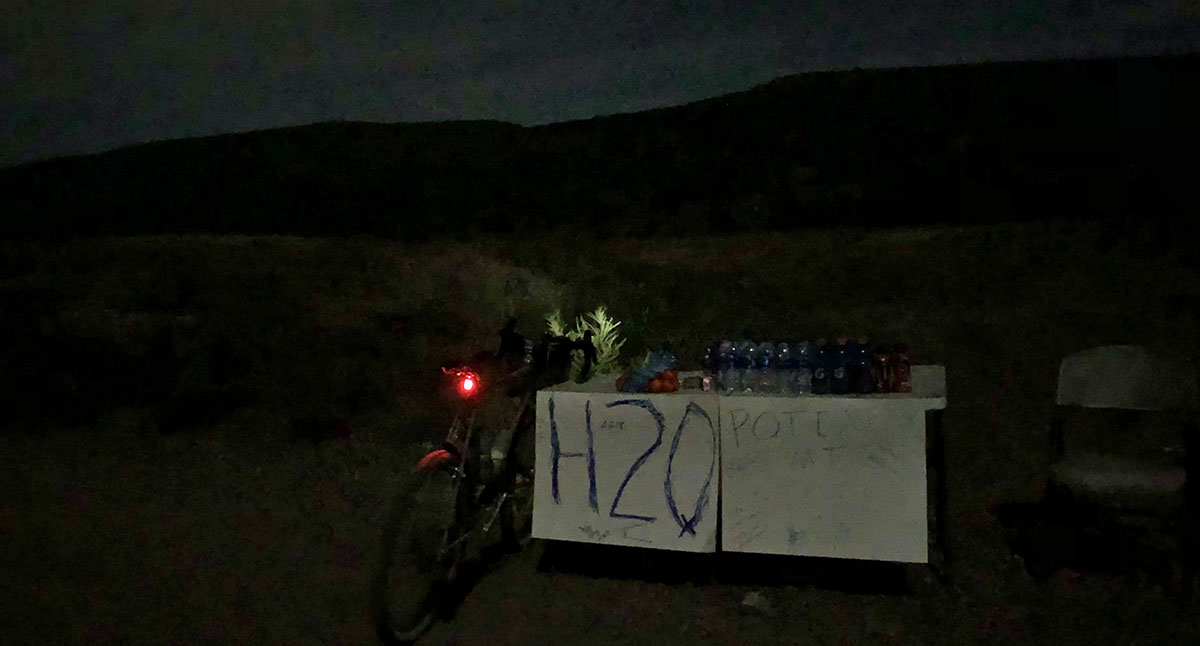Jan Wins AR High Country Race (South Loop)
Sometimes non-cyclists wonder why we do this. Why do we ride such long distances? Why do we push ourselves to the limit? Why do we spend so much time and effort making our bikes as fast and performing as possible?
It’s because extraordinary rides create extraordinary emotions. And rarely have those emotions been stronger than after finishing the Arkansas High Country Race. What a ride it’s been!
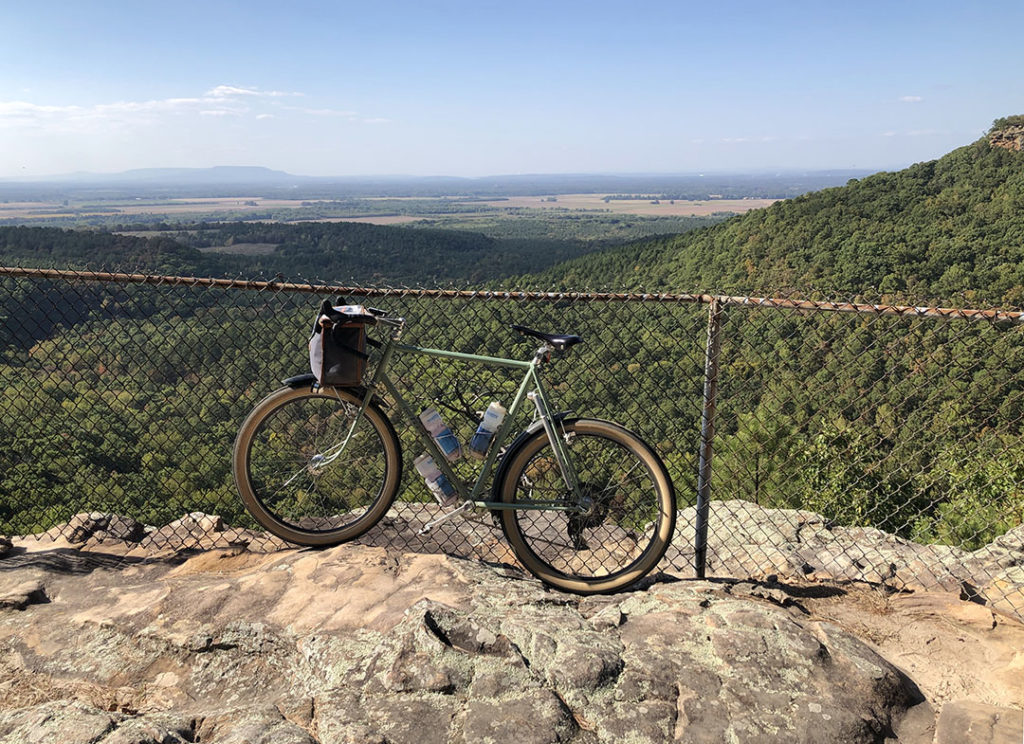
Start with the countryside. I’m still waiting for the bulk of the photos from race photographer Kai Caddy, but I can already tell you: Arkansas is spectacular. They call themselves ‘The Natural State,’ and from a cycling perspective, the title is well-deserved. Some of the best paved and gravel roads I’ve ever ridden, anywhere in the world, were part of the Arkansas High Country Race course. Narrow roads that wind into the hills. Tree canopies that touch above the road and create a beautiful komorebi pattern of light and shade. Creeks and rivers that rush over rocky beds. Cliffs and vistas over deep valleys. The full moon at night. It was incredible.
Then there were the people. I rode most of the first day with Ernie Lechuga, who’s still on the course, leading the 1000-mile category of the race. The day passed quickly as we chatted about a variety of topics.
There were the unknown people who put a water stop in the middle of nowhere (top photo). It saved my ride, since I was down to half a bottle. I hadn’t miscalculated, it was just that one of the few stores along the route was closed due to Covid, and the next resupply was more than 10 hours—a whole night—away. The AHCR is truly an adventure.
I briefly met Aaron Anzen, who rode the race in the opposite direction (the AHCR gives you a choice) at almost exactly the half-way point. It was a joyful encounter after a long night in the hills! Kuya Takami, hot in pursuit of Ernie on the 1000-mile course, passed me on the second morning—a clear sign I needed some rest, so I lay down in a field, took off my shoes and helmet, and closed my eyes for 15 minutes.
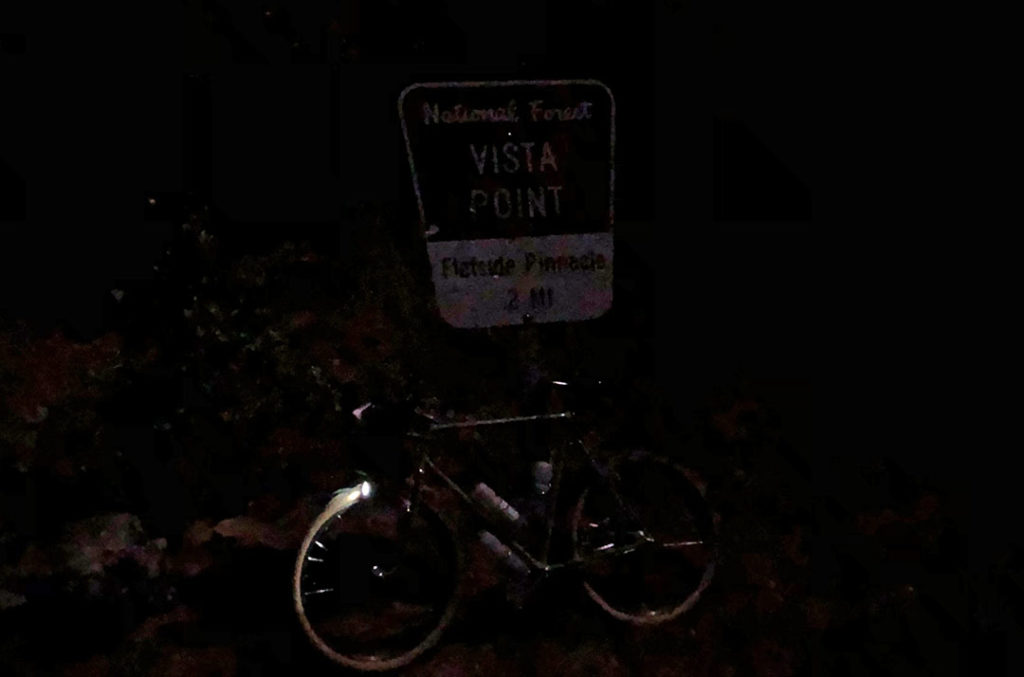
That gave me a second wind, and I was able to build my lead in my category, the South Loop race. There was some flat terrain in the Arkansas River Valley. (Flat is relative—that’s where the second photo was taken.) Then came the piece de résistance: The last night included 50 miles of relentless and steep gravel climbs in the forests between Little Rock and Hot Springs. The photo above was taken at one checkpoint. There’s nobody there—you take a photo with your bike as proof of passage. It took much photoshop to bring out any detail. Even the full moon didn’t penetrate the dense tree canopy. It was dark in the forest!
That section was hard, but two days later, I remember mostly the incredible descents. If you climb 10,000 m (33,000 ft), you also get to descend them! Rushing down these incredibly steep hills, the beam of my Edelux illuminating the road like a car headlight. Braking hard for the many turns, feeling the front tire close to the lockup point—and briefly locking once in a while when it lost traction on bumps. Getting into the aero tuck at the bottom of the descents to carry as much speed as possible into the next uphill. Getting the timing just right when to stop coasting and start pedaling to carry a maximum of speed. Shifting, shifting, shifting with SRAM’s excellent XPLR. It was an incredible rush.
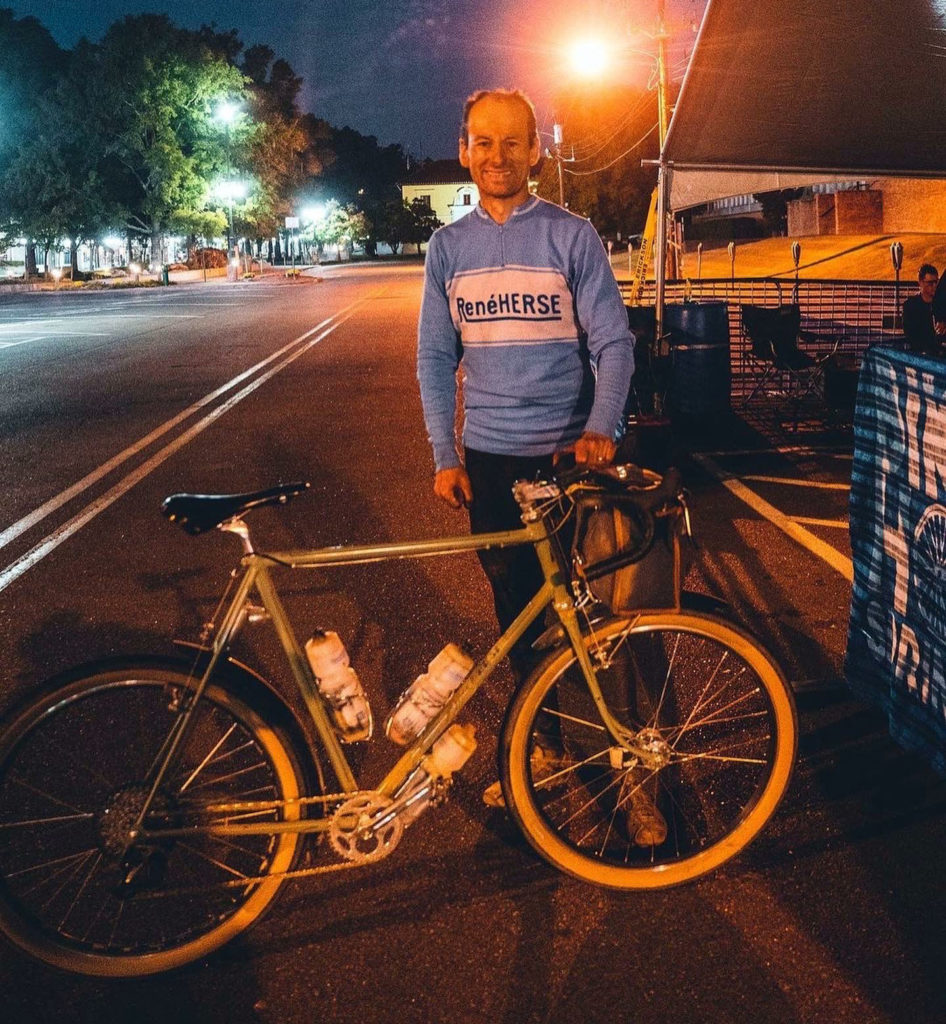
I was able to win the South Loop race. I gave it my all to finish in less than 47 hours, and managed by about 5 seconds. That’s also the new FKT (Fastest Known Time) for the South Loop of the Arkansas High Country Route.
The ride wasn’t without drama. The terrain of the Arkansas High Country Race is rougher than any I’ve ridden. Bike problems were rampant: Jackalope Cycling, co-sponsor of the race and one of very few shops along the course, reported: “This has been the most repairs I’ve seen by far! 2 complete wheels, 5 new tires (2 being cushcore), essentially 5 tune ups, prayed with one, got teary-eyed with two others, and drank 32 oz of coffee and 3 RedBull… it’s been pretty fun!” And the race isn’t over yet!
A surprising number of lead riders lost their power banks—a vital tool to recharge GPS that are essential for navigation on un-marked forest roads. I was one of them. It jumped out of my bag while I was charging my GPS. I realized quickly and remembered the big bump where it probably happened. I backtracked and found the case lying on the road. My jubilation was short-lived: The case was empty, and the actual battery pack was nowhere to be found.
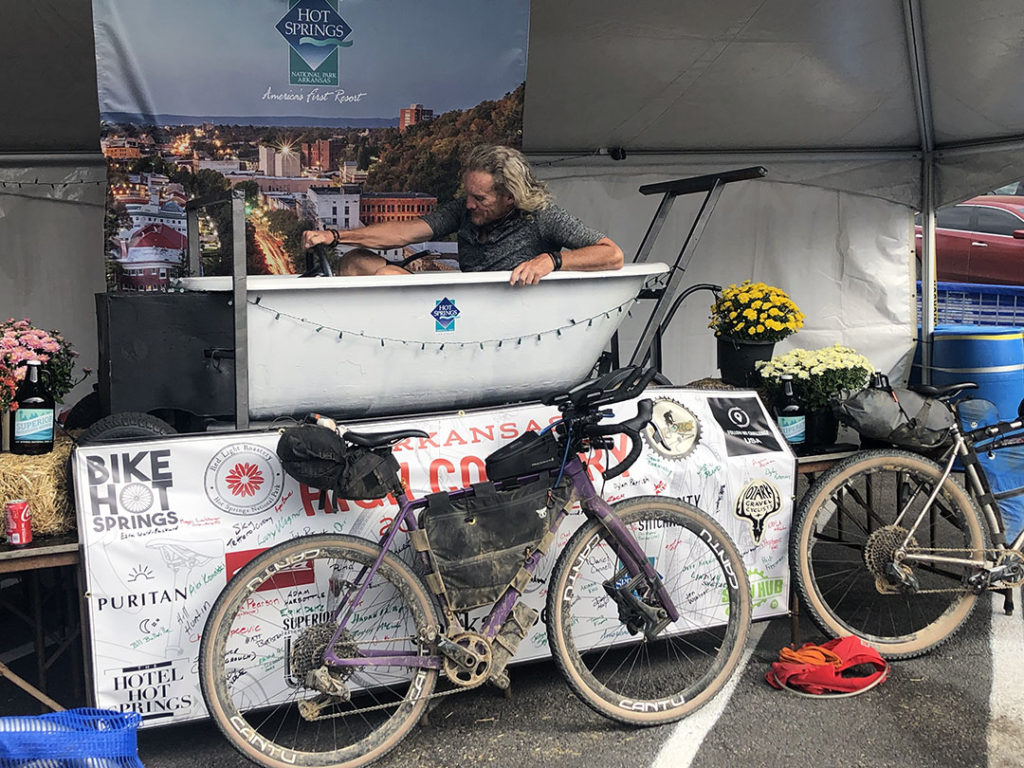
After spending almost an hour at a gas station charging my GPS and trying to figure out what to do, the second-place rider, Jim Phillips, pulled up. He had a spare power pack, and he generously loaned it to me. Talk about sportsmanship! (Above he’s at the finish—he placed third in the end.)
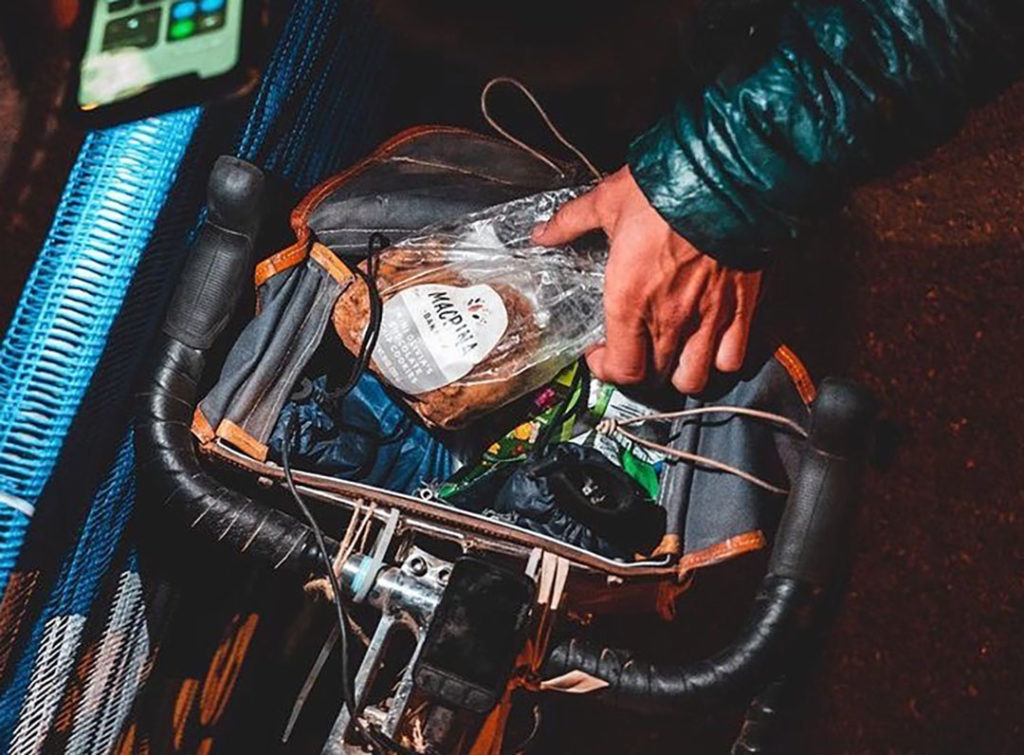
I also broke my bike’s decaleur. I knew that this part was going to be overstressed, but our new solution for ultra-rough terrain isn’t ready yet. The decaleur is designed for a bag that sits on a front rack, held down by gravity. When you take really big bumps at really high speeds, the bag jumps up, and that stresses the prongs of the decaleur. After five years of rough rides, the pins snapped off. I had brought a pair of heavy-duty zip ties for this eventuality, but I also knew that zip ties tend to break when stressed that much. So I found some twine at a store and used that to reinforce the zip ties. This solution lasted well for more than 400 miles, until the finish.
One reason to enter races like these is to stress our parts to the limit and beyond, and learn on how to improve them. (For road use, even on gravel roads, the current decaleur has proven itself over many years and 10,000s of miles.) Beyond that, the bike worked really well. I’m glad I took the Unbound XL bike instead of the Oregon Outback Rene Herse with its more limited gear range. In the Cascade Mountains, the climbs are long, but not as punishingly steep. I was happy to have a One-By with an ultra-low 36×44 gear and electronic shifting on this constantly changing terrain.
Apart from the inevitable tired muscles—all that climbing!—there are no aches or pains. Even though I forgot my gloves before the start, my hands are fine. My feet don’t hurt. No neck problems. No saddle issues. For me, that’s most important, because I ride my bike for fun.
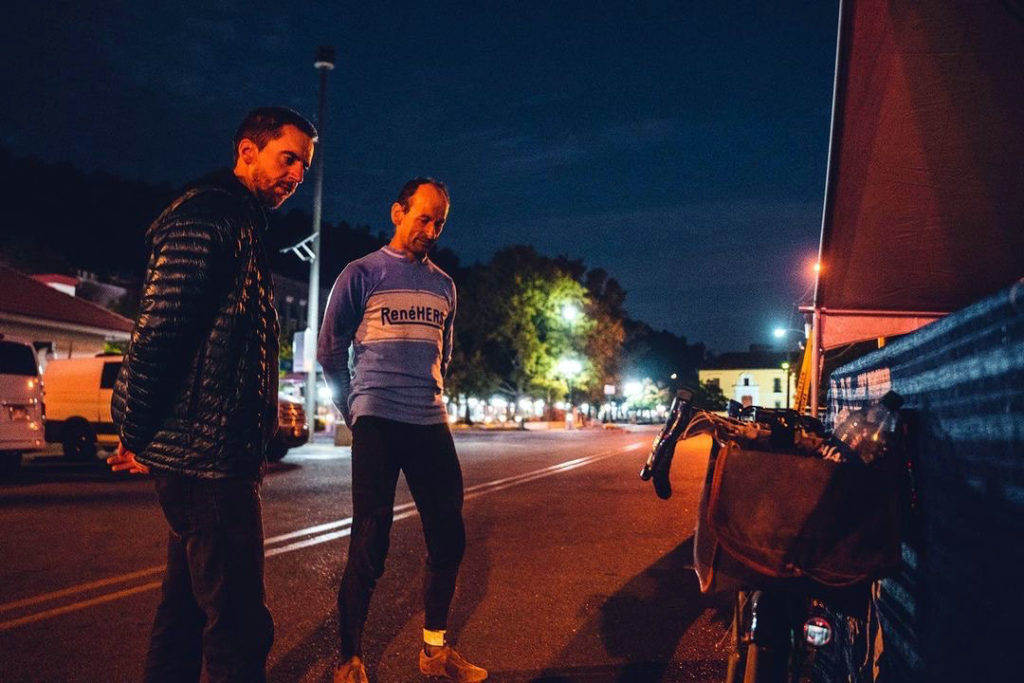
The riding was incredible, but the best part of the race was the atmosphere. Organizer Andrew Onermaa (left, at the 6 a.m. finish) is truly passionate about cycling and bikepacking. He’s put together an incredible event. To finish the race before dawn and being welcomed by the entire organizing team (plus Rebecca Rush’s mom Judy with a cowbell) was truly special. To chat about cycling, German literature and many other topics the day after the race with fellow riders (“competitors” seems like the wrong word) was just as enjoyable. We came for the cycling and challenge, but we went away with new friends.
Photos: Kai Caddy (Photos 4, 5, 6)
Further Reading:
- My ride on Strava.
- The full story of the ride with Kai Caddy’s evocative photos will be in the next Bicycle Quarterly.


